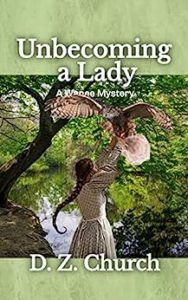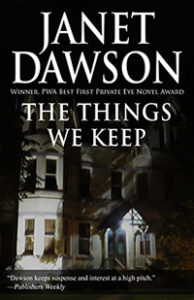A writer’s kit contains many tools. We use them to convey to readers our fictional worlds. Sight, smells, sounds—all of them invaluable. This month, we look at sounds. Those that define a period, set the scene, place the character in time, and reflect mood. Every book has its own soundtrack, whether it is playing or not. When we read of the ‘60s anyone who lived through them or watched “The Big Chill” hears those beats.
We’re not talking birds tweeting or machinery grumbling. Music, maestro, please!
D. Z. Church
The Soundtrack of Cora’s Life
 My latest book, Unbecoming a Lady, is available on Amazon in paperback and Kindle on March 15, the Kindle is open for pre-order. Here is a bit of a reveal of the back cover — more next month.
My latest book, Unbecoming a Lady, is available on Amazon in paperback and Kindle on March 15, the Kindle is open for pre-order. Here is a bit of a reveal of the back cover — more next month.
A torn sleeve, a bruised arm, and a lie.
A friend knocks on Cora Countryman’s front door seeking help with the torn sleeve of her work dress, claiming she ripped it on a bush. As the town’s seamstress, Cora has mended many a dress. So, when she sees a ragged tear in her friend’s forearm and a bruise left by a thumb, Cora questions her friend’s story. When Cora asks about the wounds, her friend is evasive. Worried by the lack of answers, Cora starts her own investigation.
The book takes place in 1876 in Wanee, Illinois a prairie town struggling with growth brought on by the changes in society resulting from the Civil War. Cora, a girl of 19 with infinite curiosity and a desire to have a life of mystery and adventure, breaks into a song she hears daily in passing one of the local bars.
She heard it most days she visited Layman’s Dry Goods store. She only knew the chorus, though. “Crying cockles and mussels, alive, alive, oh!” Cora crooned.
But Cora lives in a time without electricity, radio, television, smartphones, or even telephones. News arrives by telegraph or in the new local newspaper, The Courier. The only sources of music are the churches, the bars, and the occasional town dances if they are held at all. There is no elevator music playing in the background, heck there are no elevators, no soundtrack to her life.
Did I say church music? Cora is a Methodist and when a friend questions her about what Methodists can do, Cora responds, “We sing.” In one instance, they sing the recently written “Onward Christian Soldiers” chosen to make a point by the Methodist preacher, known by all as Preacher Havens. Or for pure joy, he might prescribe “Bringing in the Sheaves” a jubilant hymn on the Methodist playlist.
“Silver Hairs Among the Gold”, “I’ll Take you home Kathleen,” or “On the bonnie banks o’ Loch Lomond”, were new and popular, the sort of song a songstress might have sung at a town gathering or in a playhouse. If they had one. Which Wanee did not. Not in 1876.
The bars along Railroad Square, where the railroad bisects the town, would have been filled with piano players pounding out “Little Brown Jug,” “Shoo Fly Don’t Bother Me,” “Camptown Races” or another Stephen Foster song. And if the bar had a singer or a drunk with a voice they might sing, “Molly Malone,” or “The Rose of Killarney,” both new and appropriate for the bar crowd.
Cora knows the dance songs of the time, polkas, or mazurkas, and scandalously the waltz, which meant holding your partner’s hand and shoulder. But since dance music was most often provided by local musicians on the piano and/or violin the dances still tended toward square. But, it is also true that the Blue Danube Waltz, written in 1866, was well-known by 1876. Cora dreams of dancing a Viennese Waltz in Vienna on the arm of a mysterious dark-haired man.
She also wishes to drink absinthe in Paris, and float down the Nile on a boat with a red sail steered by dark men in flowing white robes. Yet here she is in Wanee with a troubled friend and her dreams on hold.
Janet Dawson
Season of the Witch
 A sunny October Saturday. Jeri Howard, Oakland private eye, is off duty. She and her fiancé Dan are helping friends go through the contents of an Alameda Victorian, showing its age and years of deferred maintenance. Once a single-family home, the house was converted to flats during World War II. Its proximity to the sprawling Naval Air Station on the west end of Alameda means any number of sailors occupied those apartments in the intervening decades.
A sunny October Saturday. Jeri Howard, Oakland private eye, is off duty. She and her fiancé Dan are helping friends go through the contents of an Alameda Victorian, showing its age and years of deferred maintenance. Once a single-family home, the house was converted to flats during World War II. Its proximity to the sprawling Naval Air Station on the west end of Alameda means any number of sailors occupied those apartments in the intervening decades.
The owner, a woman in her late seventies, has moved to a nearby senior apartment complex. Her great-nephew and his wife, assisted by Jeri and Dan, are helping to ready the place for sale.
In a dusty ground-level storeroom, Jeri finds an old Navy footlocker. It must have been left there, forgotten by a former renter. She pries open the lid. Inside are two skulls resting on a pile of bones.
Thus begins The Things We Keep, the 14th book in the series. Jeri’s no longer off duty. She’s in full investigative mode.
Those bones are old. As Jeri digs into the case, intent on learning whose bones and how they wound up there, the trail stretches back decades, to the sixties.
If ever there was a decade that had a soundtrack, it was the sixties.
The Vietnam War was raging, and Naval Air Station in Alameda was full of Navy personnel and civilian employees, with five aircraft carriers anchored there, along with a host of air squadrons. There were antiwar protests all around the country and in the Bay Area, many of them in nearby Berkeley and across the bay in San Francisco.
San Francisco was the place to be. The hippie movement began in the early sixties and so did psychedelic rock and what became known as the San Francisco sound. Cue Janis Joplin belting out “Ball and Chain” or Grace Slick’s vocal on “Somebody to Love.”
Let’s look at 1967, which began with the Human Be-In in January. Segue to Scott McKenzie singing about gentle people with flowers in their hair. It’s estimated that about 100,000 young people took the hint and flocked to San Francisco during the Summer of Love, spilling into the Haight-Ashbury neighborhood near Golden Gate Park. In June the flower children, and some of the characters in the book, headed down to Monterey for the pop festival and heard everyone from Jimi Hendrix to Canned Heat, Otis Redding and Booker T. and the MGs, Jefferson Airplane and Big Brother and the Holding Company. Joplin tore the place down, says a character in The Things We Keep.
Summer inevitably leads to autumn. In October 1967 came a mock funeral commemorating the Death of the Hippie, meant to signify the end of the movement, killed by too many wandering kids, too much media coverage, and in the end, too much of the dark side, as another character in the book comments. Though mustaches, beards, sideburns, and longer hair became mainstream, and colorful, multi-ethnic clothing dominated the fashion world.
Back in 1966, singer Donovan released a song called “Season of the Witch.” It fits the era, which is why author David Talbot used that for the name of his book Season of the Witch: Enchantment, Terror, and Deliverance in the City of Love. It’s a fascinating look at San Francisco from the late 1960s to the early 1980s.
As Jeri’s investigation progresses in The Things We Keep, she encounters the music of the late sixties and the early seventies. Janis Joplin’s “Piece of My Heart.” Jimi Hendrix and “All Along the Watchtower.” Laura Nyro, wrapping her wonderful voice around “Wedding Bell Blues.”
And the album that will always say 1974 to me: Court and Spark by Joni Mitchell, and the song from that collection that always runs through my head, “Help Me.” Turns out that’s one of Jeri’s favorites.
Remember when you wear those flowers in your hair, this is a crime novel. Some of those people aren’t so gentle.
D. Z. Church
 A Lovely Place for Trouble
A Lovely Place for Trouble
Wanee is a fictional small town on the prairie, with the rising culture of Chicago to the right, and the open plains to the left, it seems the last place to find trouble. The Mississippi River, thirty-five miles to the west, is the dividing line between civilization and the frontier. On the western bank, Indian Wars and raids are a part of life and foreshadow Custer’s Last Stand in June 1876. The restless and the hardy have taken a raft across the river hoping to make home in the fearsome weather of the grasslands.
On the eastern bank, Wanee feels settled, it has a druggist, a dry goods store, a greengrocer, and churches of most denominations. Everything a town with ideas needs to support itself and the farmers who rely on its commerce—and the workers its bars. It is a railroad hub with stockyards for hogs headed east, as the old saying goes: Why do people change trains in Chicago, pigs don’t. New businesses have arrived brought in by the influx of men set adrift by the Civil War, seeking work and a decent place to live. And the new businesses lure more men to town.
There is a town park, four by eight blocks, or a ¼ by a ½ mile with a five-acre pond rambling through it. The park is green with chestnut, walnut, and sycamore trees. The banks of the pond are lined with quince and willow. Ducks love it there and so do lovers who can meet surreptitiously under the protecting boughs of the willows.
It has a new building, dubbed Library Hall, a three-story brick structure that houses everything from the new lending library to the constable and jail. The community room within is the town meeting place.
Countryman House across the park from Library Hall takes in boarders as does The Wanee, nearer the railroad tracks where a small village of shanties has sprung up to house the workers: boilermakers, railroad men, and miners. The area disparaged as Railtown is worrisome to Wanee’s founding fathers, too new, with too many people, and too much dirt.
And therein lies the conflict. A host of rough unmarried men and not a young woman from the right side of the tracks available to marry. Not if their fathers can help it.
This is Wanee, Illinois. The home of Cora Countryman.
NOTE: Wanee is not completely fictional, it is loosely based on my hometown and its rich history.
